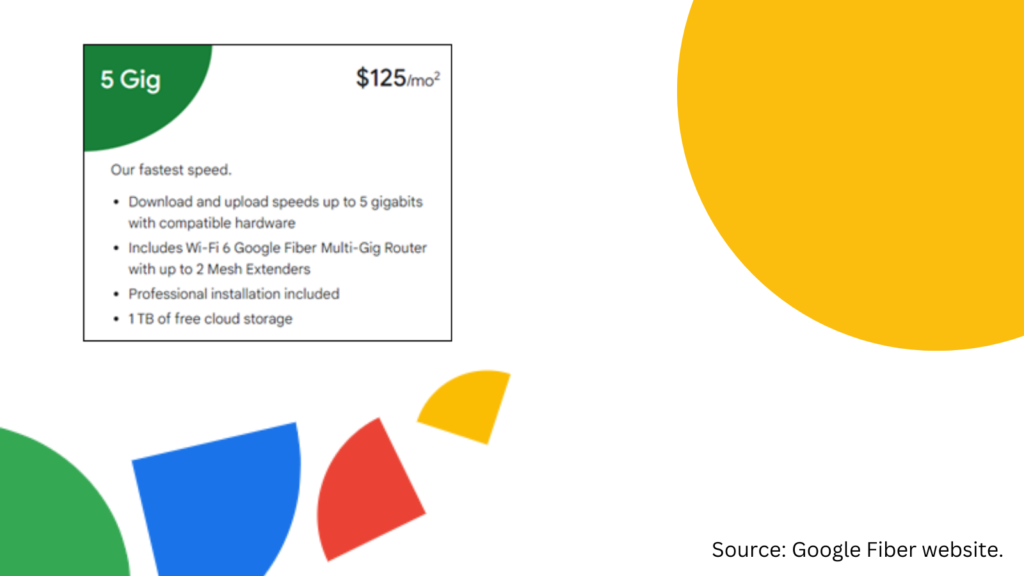Google Fiber made good on one of its 2022 promises and launched a symmetrical 5 Gbps fiber Internet tier to four markets in mid-February.

Impact: Last October, Google Fiber revealed it would roll out faster multi-gigabit broadband options in early 2023, in part to keep up with other fiber players that had launched multi-gigabit speeds greater than its own top tier of 2 Gbps downstream and 1 Gbps upstream. At the time Google Fiber revealed its multi-gig plans, several providers offered faster speeds than it did, a surprising turn of events for a company that played a pivotal role in the widespread availability of gigabit service more than 10 years ago. AT&T and Ziply Fiber started offering 2 Gbps and 5 Gbps service in early 2022, Lumen launched 3 Gbps and 8 Gbps tiers over the summer, TDS rolled out its own 8 Gbps tier in December, and Frontier lit up 5 Gbps service last month. But now Google Fiber has caught up somewhat with the unveiling of a symmetrical 5 Gbps tier in three of its original markets (Kansas City, Provo, and Salt Lake City) and in its West Des Moines expansion market.
Google Fiber plans to expand the 5 Gbps tier to additional markets later this year and still has that 8 Gbps tier with a projected $150/mo price point lurking in the wings, with a launch expected soon. But for now, the service, priced at $125/mo, can only be found in four initial launch markets. It comes with what Google Fiber described as a “10 Gig Fiber Jack,” meaning customers will already have compatible equipment when it launches even faster speed options. That hints that Google Fiber won’t stand pat at 8 Gbps, and considering Google Fiber reported successful tests of speeds up to 20 Gbps last fall, it seems pretty certain the company could jump to a 10 Gbps or faster tier soon. So not only is Google Fiber now more on par with the larger fiber players in the market, but it offers lower prices and could theoretically leapfrog them to 10 Gbps service.
In markets like Kansas City where there’s some overlap with AT&T’s hyper-gig fiber offerings, which start at $115/mo for 2 Gbps and $185/mo for 5 Gbps before promotions, Google Fiber’s lower prices could provide it with a significant advantage. And once Google Fiber expands the 5 Gbps offering to more markets, it will go head-to-head with AT&T in eight additional markets: Atlanta, Austin, Charlotte, Huntsville, Nashville, Orange County, Raleigh-Durham, and San Antonio. There’s less overlap between Google Fiber and Frontier, which prices its 2 Gbps and 5 Gbps tiers at $109.99/mo and $164.99/mo, respectively, before promotions. But many of Lumen’s planned fiber expansion markets, like Boise, Denver, and Phoenix, overlap with a Google Fiber expansion strategy that’s focused on opportunities in Arizona, Colorado, Idaho, Nebraska, and Nevada. Lumen offers its 3 Gbps tier at $150/mo, and its 8 Gbps service rings in at $300/mo.
Google Fiber has also made progress on the expansion front. The week before the 5 Gbps launch, it added Chandler, AZ, and Westminster, CO, to its expansion list. The company had previously announced plans to expand to Mesa, AZ, and Lakewood, CO, and adding a second market in each state suggests that it wants to further cement its presence in the Denver and Phoenix markets. The Chandler and Mesa buildouts are adjacent to each other in the Phoenix suburbs, where Google Fiber will compete with incumbent cable operator Cox. But the Comcast-dominated Denver suburbs of Lakewood and Westminster don’t share a border, which raises the question of whether Google Fiber will build two separate networks in those locations or if it will seek to bridge the gap by forging agreements to build in other Denver area suburbs between the two. Google Fiber has announced a planned expansion into Omaha (also a Cox market) and is said to be in talks to deploy fiber in Boise (Cable One) and with officials in at least one market in Nevada.
